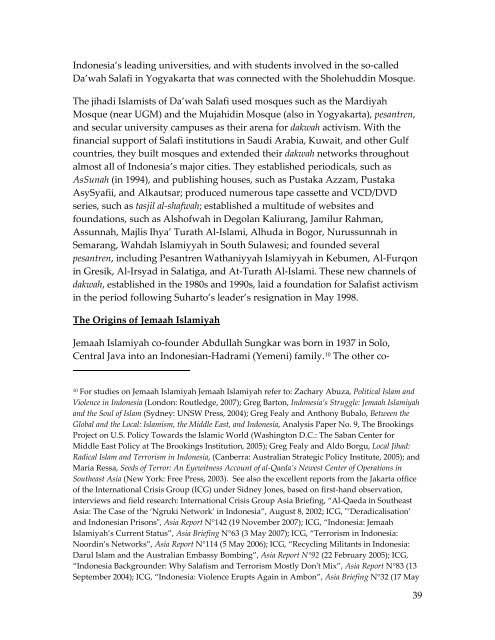You also want an ePaper? Increase the reach of your titles
YUMPU automatically turns print PDFs into web optimized ePapers that Google loves.
Indonesia’s leading universities, and with students involved in the so-called<br />
Da’wah Salafi in Yogyakarta that was connected with the Sholehuddin Mosque.<br />
The jihadi Islamists of Da’wah Salafi used mosques such as the Mardiyah<br />
Mosque (near UGM) and the Mujahidin Mosque (also in Yogyakarta), pesantren,<br />
and secular university campuses as their arena for dakwah activism. With the<br />
financial support of Salafi institutions in Saudi Arabia, Kuwait, and other Gulf<br />
countries, they built mosques and extended their dakwah networks throughout<br />
almost all of Indonesia’s major cities. They established periodicals, such as<br />
AsSunah (in 1994), and publishing houses, such as Pustaka Azzam, Pustaka<br />
AsySyafii, and Alkautsar; produced numerous tape cassette and VCD/DVD<br />
series, such as tasjil al-shafwah; established a multitude of websites and<br />
foundations, such as Alshofwah in Degolan Kaliurang, Jamilur Rahman,<br />
Assunnah, Majlis Ihya’ Turath Al-Islami, Alhuda in Bogor, Nurussunnah in<br />
Semarang, Wahdah Islamiyyah in South Sulawesi; and founded several<br />
pesantren, including Pesantren Wathaniyyah Islamiyyah in Kebumen, Al-Furqon<br />
in Gresik, Al-Irsyad in Salatiga, and At-Turath Al-Islami. These new channels of<br />
dakwah, established in the 1980s and 1990s, laid a foundation for Salafist activism<br />
in the period following Suharto’s leader’s resignation in May 1998.<br />
The Origins of Jemaah Islamiyah<br />
Jemaah Islamiyah co-founder Abdullah Sungkar was born in 1937 in Solo,<br />
10<br />
Central Java into an Indonesian-Hadrami (Yemeni) family. The other co-<br />
10<br />
For studies on Jemaah Islamiyah Jemaah Islamiyah refer to: Zachary Abuza, Political Islam and<br />
Violence in Indonesia (London: Routledge, 2007); Greg Barton, Indonesia’s Struggle: Jemaah Islamiyah<br />
and the Soul of Islam (Sydney: UNSW Press, 2004); Greg Fealy and Anthony Bubalo, Between the<br />
Global and the Local: Islamism, the Middle East, and Indonesia, Analysis Paper No. 9, The Brookings<br />
Project on U.S. Policy Towards the Islamic World (Washington D.C.: The Saban Center for<br />
Middle East Policy at The Brookings Institution, 2005); Greg Fealy and Aldo Borgu, Local Jihad:<br />
Radical Islam and Terrorism in Indonesia, (Canberra: Australian Strategic Policy Institute, 2005); and<br />
Maria Ressa, Seeds of Terror: An Eyewitness Account of al-Qaeda’s Newest Center of Operations in<br />
Southeast Asia (New York: Free Press, 2003). See also the excellent reports from the Jakarta office<br />
of the International Crisis Group (ICG) under Sidney Jones, based on first-hand observation,<br />
interviews and field research: International Crisis Group Asia Briefing, “Al-Qaeda in Southeast<br />
Asia: The Case of the ‘Ngruki Network’ in Indonesia”, August 8, 2002; ICG, "’Deradicalisation’<br />
and Indonesian Prisons", Asia Report N°142 (19 November 2007); ICG, “Indonesia: Jemaah<br />
Islamiyah’s Current Status”, Asia Briefing N°63 (3 May 2007); ICG, “Terrorism in Indonesia:<br />
Noordin’s Networks”, Asia Report N°114 (5 May 2006); ICG, “Recycling Militants in Indonesia:<br />
Darul Islam and the Australian Embassy Bombing”, Asia Report N°92 (22 February 2005); ICG,<br />
“Indonesia Backgrounder: Why Salafism and Terrorism Mostly Don't Mix”, Asia Report N°83 (13<br />
September 2004); ICG, “Indonesia: Violence Erupts Again in Ambon”, Asia Briefing N°32 (17 May<br />
39


